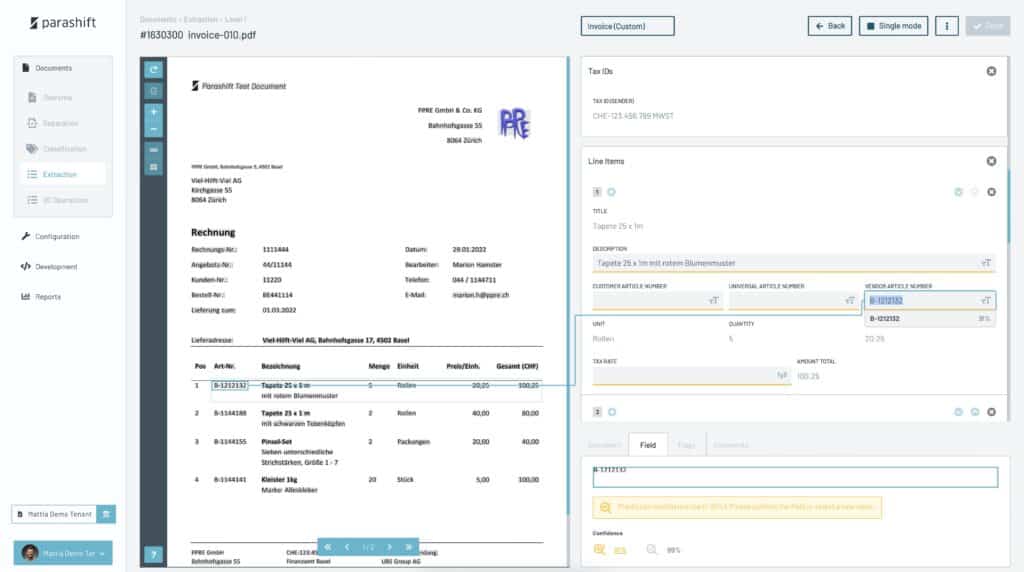Introduction
Within the vast, intricate realm of enterprise operations, the inefficiency of document processing emerges as a formidable challenge. This issue, seemingly mundane, significantly impacts productivity, operational costs, and data integrity. Intelligent Document Processing (IDP) solutions stand as a beacon of innovation, promising a substantial transformation in the handling of documents across large organizations.
The Enterprise document challenge
Enterprises are overwhelmed daily by vast volumes of documents, including invoices, contracts, customer communications, and regulatory filings. Traditional document management methods, heavily reliant on manual processing, are slow, error-prone, and inefficient, significantly hindering workflow efficiency and the ability to scale operations. This manual approach also introduces risks around data security and regulatory compliance, with human errors potentially leading to significant compliance and legal exposures.
The agility and accuracy in processing these documents are critical for maintaining a competitive edge and ensuring regulatory compliance. Quick and accurate document handling affects customer satisfaction, operational efficiency, and strategic decision-making. Moreover, enterprises must ensure the integrity and confidentiality of information, while also adhering to strict regulatory standards. Given the shortcomings of manual processing, it’s evident that a more sophisticated, technology-driven approach is necessary for enterprises to succeed in the fast-paced and competitive business landscape.
IDP to the rescue: Precision, Efficiency, Scalability
IDP solutions harness the power of AI, machine learning, and OCR to automate the extraction and processing of data from an array of document types. This automation is not just about replacing human effort; it’s about enhancing accuracy, speeding up processes, and enabling scalability. IDP systems, through continuous learning, adapt to new document formats, refine data extraction techniques, and improve over time, offering a dynamic solution to the static problem of document processing.
How IDP works: The technical journey
When an enterprise implements an IDP solution, the process unfolds in several technical steps. Initially, documents are scanned or uploaded into the system, where OCR technology converts images of text into machine-encoded text. Following this, machine learning algorithms take over, classifying the documents into categories and extracting relevant data based on predefined templates and criteria. This data is then validated for accuracy, with AI models cross-referencing information and learning from corrections to improve future processing. Finally, the extracted data is integrated into the enterprise’s existing systems, ready for analysis and action. This seamless process, from document ingestion to data integration, underscores the technical prowess of IDP solutions in transforming document processing workflows.
How does it work with the Parashift IDP Platform

Implementing Intelligent Document Processing (IDP) solutions in the enterprise domain demands a thoughtful, strategic approach, especially given the intricate nature of such environments. Parashift IDP platform is meticulously crafted to address these complexities, offering a solution that is not only flexible and scalable but also seamlessly integrates with a variety of existing enterprise systems.
At the heart of Parashift IDP Platform is its advanced AI-driven technology. This technology does more than just automate the tedious task of document processing; it intelligently recognizes, categorizes, and extracts relevant data from documents with precision. But what truly sets Parashift apart is how it leverages machine learning algorithms. Parashift IDP Platform is using the Document Swarm Learning® technology that enables the system to continuously learn from each interaction, improving its accuracy and efficiency over time. This means that the more documents the Parashift platform processes, the smarter and more intuitive it becomes, effectively tailoring its processing capabilities to the unique needs of the enterprise.
Beyond the technical prowess of its AI and machine learning algorithms, Parashift emphasizes ease of integration. The platform is designed to work harmoniously with existing IT infrastructures, ensuring that enterprises can adopt IDP without disrupting their current operations. This integration extends to various enterprise resource planning (ERP) systems, customer relationship management (CRM) platforms, and other critical business applications, facilitating a unified, efficient workflow across the organization.
The platform is accompanied by comprehensive support and training resources, ensuring that teams can leverage its full potential. This ongoing support is crucial for navigating the nuances of digital transformation, empowering enterprises to make the most of their IDP investment.
The Parashift IDP platform is more than a tool for tackling the challenge of document processing inefficiencies; it’s a strategic partner in the digital transformation journey. With its AI-driven approach, seamless integration, and robust support system, Parashift enables enterprises to confidently step into the future of automated document processing, ensuring they remain competitive and agile in the ever-evolving business landscape.
The competitive edge: Data-Driven decision making
The best advantage of integrating an Intelligent Document Processing (IDP) solution into enterprise operations lies in its capacity to facilitate data-driven decision-making. This process transforms the traditionally manual and cumbersome task of extracting and analyzing data from documents into a streamlined, automated workflow. As a result, enterprises can access and leverage a wealth of information that was previously hidden within paper documents and PDFs. This newly accessible data can then be utilized to discern patterns, refine processes, and guide strategic business decisions.
The essence of IDP’s contribution to data-driven decision-making is its ability to offer insights that are both timely and relevant. For instance, automating the extraction of data from financial documents allows for a quicker analysis of cash flow trends, which can inform more strategic financial planning and management decisions. Similarly, analyzing customer feedback forms or service requests can provide valuable insights into customer satisfaction and areas for improvement.
Moreover, the integration of IDP solutions into enterprise systems facilitates a more holistic view of operations. By feeding extracted data into Enterprise Resource Planning (ERP) systems, Customer Relationship Management (CRM) platforms, or other operational tools, businesses can enhance their analytics and reporting capabilities. This integration helps in identifying inefficiencies, understanding customer behaviors, and forecasting business needs with greater accuracy.
